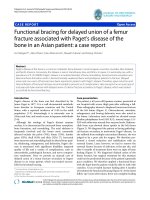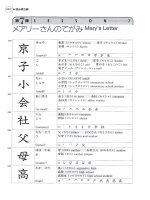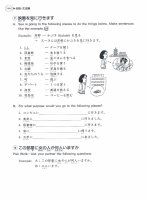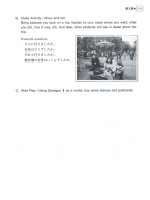Combining the Two in an Integrated Pre-service Science Content Course
Bạn đang xem bản rút gọn của tài liệu. Xem và tải ngay bản đầy đủ của tài liệu tại đây (696 KB, 39 trang )
How People Learn and How People
How People Learn and How People
Teach: Combining the Two in an
Teach: Combining the Two in an
Integrated Pre-service Science
Integrated Pre-service Science
Content Course
Content Course
Dr. Brad Hoge and Dr. Scott Slough
Dr. Brad Hoge and Dr. Scott Slough
University of Houston – Downtown
University of Houston – Downtown
Constructivism informs our view of how people learn,
Constructivism informs our view of how people learn,
which in turn informs our view of how we teach
which in turn informs our view of how we teach
science to pre-service teachers. This paper
science to pre-service teachers. This paper
discusses the conflict, and hopefully some
discusses the conflict, and hopefully some
resolutions, between implementing constructivitic
resolutions, between implementing constructivitic
teaching methodologies while attempting to
teaching methodologies while attempting to
integrate physical science and earth science
integrate physical science and earth science
content into a single course for pre-service
content into a single course for pre-service
elementary teachers within the Natural Science
elementary teachers within the Natural Science
Department at UH-Downtown.
Department at UH-Downtown.
Science education has been moving towards an
Science education has been moving towards an
inquiry based constructivism since the early 90’s,
inquiry based constructivism since the early 90’s,
due to the goals and guidelines of The National
due to the goals and guidelines of The National
Science Teachers Association (1992), The
Science Teachers Association (1992), The
American Association for the Advancement of
American Association for the Advancement of
Science (1993), and the National Research Council
Science (1993), and the National Research Council
(1996).
(1996).
The National Science Education Standards call for a
The National Science Education Standards call for a
shift in emphasis from “focusing on student
shift in emphasis from “focusing on student
acquisition of information to focusing on student
acquisition of information to focusing on student
understanding and use of scientific knowledge,
understanding and use of scientific knowledge,
ideas, and inquiry processes” (NRC, 1996)
ideas, and inquiry processes” (NRC, 1996)
NSF Standards for Inquiry
NSF Standards for Inquiry
Students should understand that in science:
Students should understand that in science:
►
Investigations involve asking a question and
Investigations involve asking a question and
comparing the answer to what is known
comparing the answer to what is known
►
Explanations emphasize evidence
Explanations emphasize evidence
►
Explanations have logically consistent arguments
Explanations have logically consistent arguments
►
Investigations are repeatable by others
Investigations are repeatable by others
►
Scientists make their results public, review and ask
Scientists make their results public, review and ask
each other questions
each other questions
Constructivist views of learning provide a theoretical
Constructivist views of learning provide a theoretical
framework to teachers in helping students
framework to teachers in helping students
reconstruct their own understanding through a
reconstruct their own understanding through a
process of interacting with objects in the
process of interacting with objects in the
environment and engaging in higher-level thinking
environment and engaging in higher-level thinking
and problem solving (Driver, Asoko, Leach,
and problem solving (Driver, Asoko, Leach,
Mortimer, & Scott, 1994).
Mortimer, & Scott, 1994).
Constructivism provides the theoretical framework
Constructivism provides the theoretical framework
for all forms of project-based learning (Grant,
for all forms of project-based learning (Grant,
2002).
2002).
PBS pedagogy (Schneider, Krajcik, Marx, & Soloway,
PBS pedagogy (Schneider, Krajcik, Marx, & Soloway,
2002) assumes that students constantly ask and
2002) assumes that students constantly ask and
refine questions; design and conduct multiple
refine questions; design and conduct multiple
investigations; gather, analyze, interpret, and
investigations; gather, analyze, interpret, and
draw conclusions from data; and report findings.
draw conclusions from data; and report findings.
. . . by extension, learning scientific process
. . . by extension, learning scientific process
(literacy) extends beyond the classroom
(literacy) extends beyond the classroom
(Bransfield etal, 1999).
(Bransfield etal, 1999).
Scientists explore the physical world for reproducible
Scientists explore the physical world for reproducible
patterns which they represent by models and
patterns which they represent by models and
organize into theories according to laws (Hestenes,
organize into theories according to laws (Hestenes,
2004).
2004).
Constructivism posits that individuals build their own
Constructivism posits that individuals build their own
knowledge and understanding by assimilating their
knowledge and understanding by assimilating their
prior knowledge with the new experience with
prior knowledge with the new experience with
which they are confronted (Richardson, 1997).
which they are confronted (Richardson, 1997).
Individuals do not obtain knowledge by internalizing
Individuals do not obtain knowledge by internalizing
it from the outside but by constructing it from
it from the outside but by constructing it from
within, in interaction with the environment (Kamii,
within, in interaction with the environment (Kamii,
Manning, & Manning, 1991; Perkins, 1992; Piaget,
Manning, & Manning, 1991; Perkins, 1992; Piaget,
1969; Vygotsky, 1978)
1969; Vygotsky, 1978)
Thus, constructivism is based on the premise that,
Thus, constructivism is based on the premise that,
by reflecting on our experiences, we construct our
by reflecting on our experiences, we construct our
own understanding of the world we live in.
own understanding of the world we live in.
Learning is a process of modifying our mental
Learning is a process of modifying our mental
models to accommodate new experiences.
models to accommodate new experiences.
Research shows that students learn science best by
Research shows that students learn science best by
engaging in hands-on minds-on lessons through a
engaging in hands-on minds-on lessons through a
inquiry based curriculum (Abell and Bryan, 1997;
inquiry based curriculum (Abell and Bryan, 1997;
Stepans, et. al., 1995: Metz, 1995; Glasson,
Stepans, et. al., 1995: Metz, 1995; Glasson,
1989).
1989).
What is often overlooked, is how important it is to
What is often overlooked, is how important it is to
incorporate this constructivist strategy into pre-
incorporate this constructivist strategy into pre-
service teacher education (Bodzin and Cates,
service teacher education (Bodzin and Cates,
2003; Kelly, 2000).
2003; Kelly, 2000).
Inquiry is a fundamental component of effective
Inquiry is a fundamental component of effective
science teaching and learning (Lunetta, 1997;
science teaching and learning (Lunetta, 1997;
Roth, 1995).
Roth, 1995).
Inquiry-based instruction allows students to make
Inquiry-based instruction allows students to make
connections between the classroom experience
connections between the classroom experience
and their personal lives.
and their personal lives.
Learning becomes relevant to students.
Learning becomes relevant to students.
Without preparing teachers with this learning
Without preparing teachers with this learning
strategy, the benefits of inquiry-based science
strategy, the benefits of inquiry-based science
does not trickle down to students (Slater, et. al.,
does not trickle down to students (Slater, et. al.,
1996; Stepans, et. al., 1995; Michelsohn and
1996; Stepans, et. al., 1995; Michelsohn and
Hawkins, 1994; Fullan and Stiege, 1991; Doyle
Hawkins, 1994; Fullan and Stiege, 1991; Doyle
and Ponder, 1977).
and Ponder, 1977).
Restructuring science content courses for teachers is
Restructuring science content courses for teachers is
the logical place for these skills to be taught, since
the logical place for these skills to be taught, since
this is where teachers learn to connect science
this is where teachers learn to connect science
content to their own “special knowledge” (Marek
content to their own “special knowledge” (Marek
et.al., 2003: Kelly, 2000; Shulman, 1986).
et.al., 2003: Kelly, 2000; Shulman, 1986).
The ever-expanding knowledge base in science, new
The ever-expanding knowledge base in science, new
technologies for teaching and learning, high-stakes
technologies for teaching and learning, high-stakes
testing and increased accountability have
testing and increased accountability have
produced an overburdened local curriculum in
produced an overburdened local curriculum in
science and mathematics (NRC, 1996).
science and mathematics (NRC, 1996).
This has led, in many instances, to an increase in the
This has led, in many instances, to an increase in the
number of courses pre-service teachers must
number of courses pre-service teachers must
complete, or, an integration of content across
complete, or, an integration of content across
disciplines.
disciplines.
In particular, high stakes testing has been widely
In particular, high stakes testing has been widely
blamed for curricula that are “a mile wide and an
blamed for curricula that are “a mile wide and an
inch deep” (NRC, 1997).
inch deep” (NRC, 1997).
Therefore, science education of pre-service teachers
Therefore, science education of pre-service teachers
should utilize more appropriate metacognitive
should utilize more appropriate metacognitive
psychology.
psychology.
We teach our content courses for pre-service
We teach our content courses for pre-service
teachers through hands-on research-based
teachers through hands-on research-based
projects within a constructivist ideology, as a
projects within a constructivist ideology, as a
model of how we would like them to teach in their
model of how we would like them to teach in their
own classrooms.
own classrooms.
This teaching method already puts a lot of pressure
This teaching method already puts a lot of pressure
on content coverage, how then can we double the
on content coverage, how then can we double the
load and increase learning?
load and increase learning?
We have developed a new paradigm for teaching
We have developed a new paradigm for teaching
science, a more metacognitive constructivism.
science, a more metacognitive constructivism.
Our paradigm draws on the research into how
Our paradigm draws on the research into how
learning takes place as well as how it can best be
learning takes place as well as how it can best be
taught.
taught.
It calls for a hierarchical metacognition which
It calls for a hierarchical metacognition which
cascades through ranks and generations, rather
cascades through ranks and generations, rather
than just being passed on.
than just being passed on.
A more whole brain, whole body approach will also
A more whole brain, whole body approach will also
lead to greater retention of content knowledge.
lead to greater retention of content knowledge.
Our metacognitive approach to teaching science
Our metacognitive approach to teaching science
requires knowledge of the history of the science,
requires knowledge of the history of the science,
current science knowledge and practice, and
current science knowledge and practice, and
theories of explanation.
theories of explanation.
E.O. Wilson stated, the benefits of metaphor over
E.O. Wilson stated, the benefits of metaphor over
analogy in teaching science is rooted in our
analogy in teaching science is rooted in our
evolutionary past. We use metaphor to make
evolutionary past. We use metaphor to make
sense of our world.
sense of our world.
Integrated science provides metaphors by relating
Integrated science provides metaphors by relating
knowledge from one field as examples for lessons
knowledge from one field as examples for lessons
in another, such as the application of physics to
in another, such as the application of physics to
earth science.
earth science.









